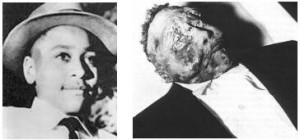At about 2.30 am on 28th August 1955, a fourteen-year-old boy named Emmett Till was kidnapped at gunpoint from his great-uncle’s house in Money, Mississippi. His kidnappers then drove to a disused plantation shed in neighboring Sunflower County, where they brutally beat the teenager, gouging out one eye. A witness heard Till’s screams for hours until his tormenters finally shot him in the head with a .45-caliber pistol. They then tied a seventy-five-pound cotton gin fan around his neck with barbed wire in an unsuccessful attempt to weigh down Till’s body before they dumped him into the Tallahatchie River. A white teenage boy discovered the tortured, swollen, and decomposing body three days later. The fourteen-year-old had been so badly beaten and mutilated that he could only be identified by his father’s ring that he wore. This brutal murder of a teenager – and the antecedent and subsequent events – would be instrumental in launching the civil rights movement.
Emmett Louis “Bobo” Till was from Chicago and had been raised by his mother, his parents having separated in 1942. On August 20th, Till’s mother, Mamie Till Bradley, who worked in the Chicago branch of the Air Force Procurement Office, sent Emmett and his cousin, Curtis Jones, to Mississippi on vacation to stay with their uncle, Moses Wright. Mamie warned her impulsive son about the difference between segregation in the North and South, and advised him not to speak to white people.
In 1955, only fifty-five residents lived in Money, Mississippi, a cotton gin town with a gas station and three stores. On the evening of August 24th, Till and several of his cousins drove to Bryant’s Grocery and Meat Market, a small shop owned by Roy and Carolyn Bryant that served the local poor black sharecroppers. Till had boasted to his cousins about life in the North, and claimed to have a white girlfriend. When the Mississippi youths dared Till to go into the grocery store and flirt with Carolyn Bryant, an attractive twenty-one-year-old mother of two, Till took the dare. Carolyn Bryant would later testify that Till said, “Bye baby,” “What’s the matter baby? Can’t you take it?” “You needn’t be afraid of me,” and “I’ve been with white women before”; other witnesses say that Till merely “wolf whistled” as he was leaving the store. Whatever the truth, his actions were clearly shocking; Till was warned by an old man playing checkers outside the store to leave the area immediately. When Carolyn Bryant came outside to get a gun from her brother-in-law’s car, Till and his cousins fled the scene.
News of the northern teenager’s impudence quickly spread throughout the black community. Till, realising the seriousness of his actions, wanted to go back to Chicago but the Wright family reasoned that if he stayed away from Bryant’s store he would be safe. Three days later, however, Carolyn Bryant’s husband, Roy, who had been in Texas on a trucking job, returned home and discovered what had happened in his absence.
In the early hours of the morning of 28th August, Bryant and his half-brother J.W. Milam drove to Wright’s cabin and demanded to see the boy from Chicago. Wright and his wife, Elizabeth, offered to pay money for any offense caused and pleaded with the two men for mercy. Bryant and Milam ignored the pleas and ordered Till into the back of their pickup truck. After warning Wright not to cause any trouble, they then drove off to mete out their revenge.
Sheriff George Smith was informed the next morning that Till was missing. The sheriff questioned Milam and Bryant, who both admitted abducting the adolescent, but insisted that they had released him unharmed that same night. They were arrested and charged with kidnapping, which was then changed to murder when the body was found.
After her murdered son was returned to her in Chicago, in her grief and rage, Mamie Till Bradley made the decision to “let the people see what they have done to my boy,” and displayed the savagely brutalised and disfigured body in an open casket – resulting in national attention to the crime and its underlying grotesqueries. During the four days of the viewing at the Rainer Funeral Home in Chicago, thousands of northerners saw Till’s body and could no longer ignore the truth and horror of lynching. A horrific photograph of Till was published in the national press – but while it inflamed northerners, it also served to rally southerners. Until the publication of the photograph, sympathy in the south for the defendants had been non-existent and no lawyers would take the case. But as soon as Till’s murder became a national event, five prominent Mississippi attorneys suddenly came forward to defend Bryant and Milam.
The trial lasted only five days; jury deliberations took just sixty-seven minutes – one juror said they took a break to stretch the time to over an hour – and, on September 23rd 1955, an all-white, all-male jury of twelve acquitted Roy Bryant and J.W. Milam, who celebrated their whitewashed freedom on the courtroom steps. In a 1956 article for Look magazine, J.W. Milam admitted that he and his half-brother had killed Till.
The hasty acquittal and miscarriage of justice outraged people throughout the United States and Europe. Protest rallies and lectures were staged worldwide, drawing attention to the plight of black Americans. Most significantly, future civil rights activists and leaders cite the Till murder as their consciousness-raising moment. In the wake of the tragedy, the civil rights movement would begin to mobilise.



104 Responses to 28th August 1955 – the Lynching of Emmett Till